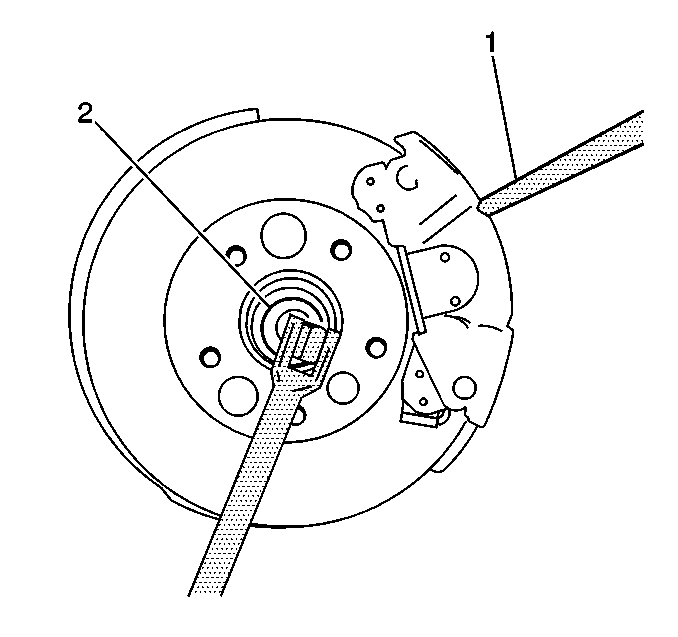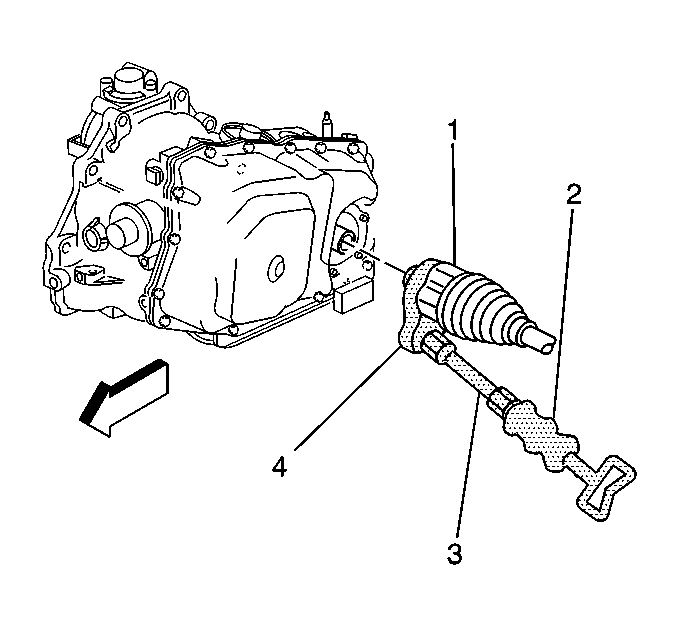Notice: Care must be exercised to prevent the constant-velocity joints from being over-extended. When either end of the drive axle is disconnected, over-extension of the joint could result in separation of internal components and possible joint failure. Drive axle joints and seals should be protected any time service is performed on or near the drive axles. Failure to observe this can result in interior joint or seal damage and possible joint failure.
Notice: Prior to removal of drive axle assembly, cover all sharp edges in the area of the drive axle with shop towels so that the seal is not damaged during removal.
Tools Required
| • | J 38892 Ball Joint Separator |
| • | J 28733-B Front Hub Spindle Remover |
| • | J 29794 Drive Axle Removal Extension |
| • | J 2619-01 Slide Hammer |
| • | J 33008 Axle Remover |
Removal Procedure
- Disconnect the negative battery cable.
- Raise and suitably support the vehicle. Refer to Lifting and Jacking the Vehicle in General Information.
- Remove the tire and the wheel assembly. Refer to Wheel Removal in Tires and Wheels.
- Place shop towels underneath the outer joint to protect from any sharp edges.
- Insert the drift or the non-ferrous drift into the caliper and the rotor to prevent the rotor from turning.
- Remove the drive axle nut and the washer.
- Remove the lower ball joint cotter pin and the nut and loosen the joint using J 38892 . If removing the right axle, turn the wheel to the left. If removing the left axle, turn the wheel to the right.
- Disconnect the ABS sensor wire.
- Disconnect the stabilizer link.
- Separate the joint by using J 38892 .
- Disengage the axle from the hub and the bearing usingJ 28733-B .
- Separate the hub and the bearing assembly from the drive axle. Move the strut and the knuckle assembly rearward.
- Remove the inner joint from the transaxle using J 33008 attached to J 29794 and J 2619-01 for the intermediate shaft, if equipped.
Caution: Unless directed otherwise, the ignition and start switch must be in the OFF or LOCK position, and all electrical loads must be OFF before servicing any electrical component. Disconnect the negative battery cable to prevent an electrical spark should a tool or equipment come in contact with an exposed electrical terminal. Failure to follow these precautions may result in personal injury and/or damage to the vehicle or its components.

Notice: Use only the recommended tools for separating the ball joint from knuckle. Failure to use recommended tools may cause damage to the ball joint and seal.


Installation Procedure
Notice: Prior to installation of drive axle assembly, cover all sharp edges in the area of the drive axle with shop towels so that the seal is not damaged during installation.
Any time the front halfshaft is removed, the transmission (the halfshaft male and female shank) and the knuckle sealing surfaces should be inspected for debris or corrosion.
If debris or corrosion are present on the sealing surfaces, clean them with a 320 grit cloth or equivalent. Transmission fluid may be used to clean off any of the remaining debris. The surface should be wiped dry, and the halfshaft should be reinstalled free of any debris or corrosion buildup.
- Install the drive axle (1) into the transaxle or the intermediate shaft by placing a non-ferrous drift into the groove on the joint housing and then tapping until seated. Be careful not to damage the axle seal or dislodge the seal garter spring when installing the axle.
- Install the drive axle into the hub and bearing assembly.
- Lower the ball joint to the knuckle.
- Install the cotter pin.
- Install the washer and the new drive axle nut.
- Insert the drift or the screwdriver into the caliper and the rotor to prevent the rotor from turning.
- Install the tire and the wheel assembly. Refer to Wheel Installation in Tires and Wheels.
- Lower the vehicle.
- Connect the negative battery cable.


Important: Verify that the drive axle is seated by grasping on the inner joint housing and pulling outboard.
Notice: Use the correct fastener in the correct location. Replacement fasteners must be the correct part number for that application. Fasteners requiring replacement or fasteners requiring the use of thread locking compound or sealant are identified in the service procedure. Do not use paints, lubricants, or corrosion inhibitors on fasteners or fastener joint surfaces unless specified. These coatings affect fastener torque and joint clamping force and may damage the fastener. Use the correct tightening sequence and specifications when installing fasteners in order to avoid damage to parts and systems.
Tighten
| • | Tighten the ball joint to the steering knuckle nut to 60 N·m (44 lb ft) minimum tightening specification - 65 N·m (48 lb ft) maximum tightening specification to install the cotter pin. |
| • | Do not loosen the nut at any time during the installation. |

Tighten
Tighten the drive axle nut to 100 N·mplus 40° rotation
(74 lb ft plus 40° rotation).
Important: Use a torque wrench to tighten the drive axle nut to specification.
